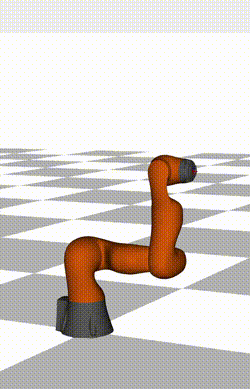Loading...
Searching...
No Matches
Robot manipulator example of robotoc::UnconstrOCPSolver and robotoc::UnconstrParNMPCSolver in C++
This page explains the example code in examples/iiwa14/task_space_ocp.cpp.

Required header files are as follows.
#include <string>
#include <memory>
#include "Eigen/Core"
#include "robotoc/solver/unconstr_ocp_solver.hpp"
#include "robotoc/solver/unconstr_parnmpc_solver.hpp"
#include "robotoc/robot/robot.hpp"
#include "robotoc/robot/se3.hpp"
#include "robotoc/cost/cost_function.hpp"
#include "robotoc/cost/configuration_space_cost.hpp"
#include "robotoc/cost/task_space_6d_cost.hpp"
#include "robotoc/constraints/constraints.hpp"
First, construct a time-varying reference for end-effector.
public:
TaskSpace6DRef()
: TaskSpace6DRefBase() {
rotm_ << 0, 0, 1,
0, 1, 0,
-1, 0, 0;
pos0_ << 0.546, 0, 0.76;
radius_ = 0.05;
}
~TaskSpace6DRef() {}
Eigen::Vector3d pos(pos0_);
pos.coeffRef(1) += radius_ * sin(M_PI*grid_info.t);
pos.coeffRef(2) += radius_ * cos(M_PI*grid_info.t);
x6d_ref = robotoc::SE3(rotm_, pos);
}
return true;
}
private:
double radius_;
Eigen::Matrix3d rotm_;
Eigen::Vector3d pos0_;
};
int main(int argc, char *argv[]) {
Base class of reference task space placement (position and orientation).
Definition: task_space_6d_ref_base.hpp:16
virtual void updateRef(const GridInfo &grid_info, SE3 &ref_6d) const =0
Computes the reference task-space placement.
virtual bool isActive(const GridInfo &grid_info) const =0
Checks wheather the cost is active or not at the specified time.
We define the robot model.
robotoc::RobotModelInfo model_info;
model_info.urdf_path = "../iiwa_description/urdf/iiwa14.urdf";
robotoc::Robot robot(model_info);
const std::string ee_frame = "iiwa_link_ee_kuka"; // end-effector frame
robot.setJointEffortLimit(Eigen::VectorXd::Constant(robot.dimu(), 50)); // change the joint limits
robot.setJointVelocityLimit(Eigen::VectorXd::Constant(robot.dimv(), M_PI_2)); // change the joint limits
Dynamics and kinematics model of robots. Wraps pinocchio::Model and pinocchio::Data....
Definition: robot.hpp:32
std::string urdf_path
Path to the URDF file.
Definition: robot_model_info.hpp:73
Next, we construct the cost function.
auto cost = std::make_shared<robotoc::CostFunction>();
auto config_cost = std::make_shared<robotoc::ConfigurationSpaceCost>(robot);
config_cost->set_q_weight(Eigen::VectorXd::Constant(robot.dimv(), 0.1));
config_cost->set_q_weight_terminal(Eigen::VectorXd::Constant(robot.dimv(), 0.1));
config_cost->set_v_weight(Eigen::VectorXd::Constant(robot.dimv(), 0.0001));
config_cost->set_v_weight_terminal(Eigen::VectorXd::Constant(robot.dimv(), 0.0001));
config_cost->set_a_weight(Eigen::VectorXd::Constant(robot.dimv(), 0.0001));
cost->add("config_cost", config_cost);
auto x6d_ref = std::make_shared<TaskSpace6DRef>();
auto task_cost = std::make_shared<robotoc::TaskSpace6DCost>(robot, ee_frame, x6d_ref);
task_cost->set_x6d_weight(Eigen::Vector3d::Constant(1000), Eigen::Vector3d::Constant(1000));
task_cost->set_x6df_weight(Eigen::Vector3d::Constant(1000), Eigen::Vector3d::Constant(1000));
cost->add("task_cost", task_cost);
We also construct the constraints.
const double barrier_param = 1.0e-03;
const double fraction_to_boundary_rule = 0.995;
auto constraints = std::make_shared<robotoc::Constraints>(barrier_param, fraction_to_boundary_rule);
auto joint_position_lower = std::make_shared<robotoc::JointPositionLowerLimit>(robot);
auto joint_position_upper = std::make_shared<robotoc::JointPositionUpperLimit>(robot);
auto joint_velocity_lower = std::make_shared<robotoc::JointVelocityLowerLimit>(robot);
auto joint_velocity_upper = std::make_shared<robotoc::JointVelocityUpperLimit>(robot);
auto joint_torques_lower = std::make_shared<robotoc::JointTorquesLowerLimit>(robot);
auto joint_torques_upper = std::make_shared<robotoc::JointTorquesUpperLimit>(robot);
constraints->add("joint_position_lower", joint_position_lower);
constraints->add("joint_position_upper", joint_position_upper);
constraints->add("joint_velocity_lower", joint_velocity_lower);
constraints->add("joint_velocity_upper", joint_velocity_upper);
constraints->add("joint_torques_lower", joint_torques_lower);
constraints->add("joint_torques_upper", joint_torques_upper);
constraints->setBarrierParam(1.0e-03);
Finally, we can construct the optimal control solver
const double T = 6;
const int N = 120;
robotoc::OCP ocp(robot, cost, constraints, T, N);
auto solver_options = robotoc::SolverOptions();
solver_options.nthreads = 4;
robotoc::UnconstrOCPSolver ocp_solver(ocp, solver_options);
Optimal control problem solver of unconstrained rigid-body systems by Riccati recursion....
Definition: unconstr_ocp_solver.hpp:35
or ParNMPC solver
const double T = 6;
const int N = 120;
robotoc::OCP parnmpc(robot, cost, constraints, T, N);
auto solver_options = robotoc::SolverOptions();
solver_options.nthreads = 4;
robotoc::UnconstrParNMPCSolver parnmpc_solver(parnmpc, solver_options);
Optimal control problem solver of unconstrained rigid-body systems by ParNMPC algorithm....
Definition: unconstr_parnmpc_solver.hpp:34
Let's run the solver!
const double t = 0;
Eigen::VectorXd q = Eigen::VectorXd::Zero(robot.dimq());
q << 0, M_PI_2, 0, M_PI_2, 0, M_PI_2, 0;
const Eigen::VectorXd v = Eigen::VectorXd::Zero(robot.dimv());
ocp_solver.discretize(t);
ocp_solver.setSolution("q", q); // initial state.
ocp_solver.setSolution("v", v); // initial state.
ocp_solver.initConstraints(); // initialize the slack and dual variables of the primal-dual interior point method.
std::cout << "Initial KKT error: " << ocp_solver.KKTError(t, q, v) << std::endl;
ocp_solver.solve(t, q, v);
std::cout << "KKT error after convergence: " << ocp_solver.KKTError(t, q, v) << std::endl;
std::cout << ocp_solver.getSolverStatistics() << std::endl; // print solver statistics
return 0;
}